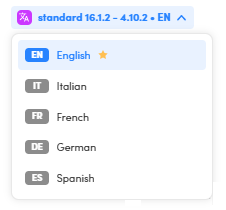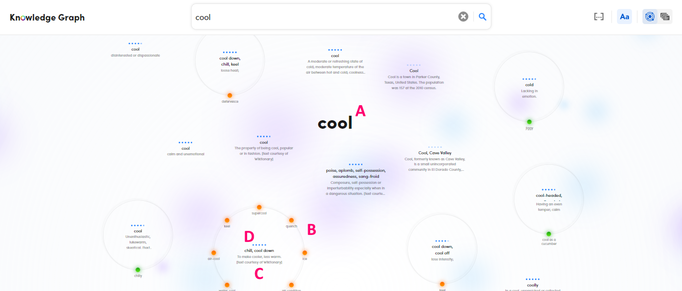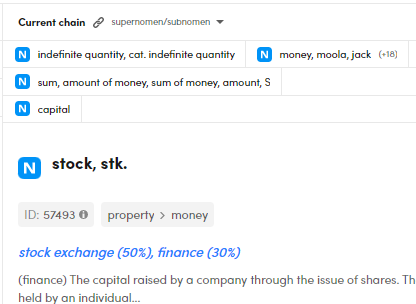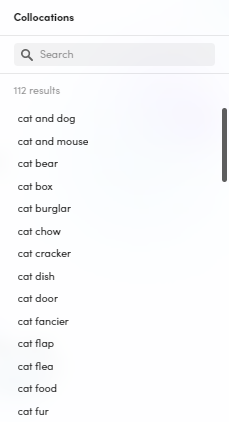Navigate the knowledge graph
Overview
Select Knowledge graph  on the main toolbar of a project's dashboard to open and navigate a knowledge graph.
on the main toolbar of a project's dashboard to open and navigate a knowledge graph.

Warning
It may take a while to load a knowledge graph the first time.
The current knowledge graph is indicated in the dropdown list in the upper left corner. The default knowledge graph corresponds to the tech version of the project and, in case of multi-language thesaurus projects, to the favorite project language.

The number of concepts (also called syncons) and the number of concept-defining lemmas of the knowledge graph are indicated above the knowledge graph selection dropdown list.
The graph on the right side of the page represents the IS-A hierarchy—also called supernomen-subnomen link chain—of concepts that descend from the root concept corresponding to the selected tab in the strip at the bottom of the page. The number of concepts that are displayed is indicated at the bottom left. It can be limited to a maximum value.

The root concept is described on the left, under CURRENT GRAPH.
Change the current knowledge graph
A project can have multiple knowledge graphs. This happens for multi-language thesaurus projects, projects based on—or containing—uploaded symbolic models (CPK packages) and knowledge graph customization projects that have been built at least one time.
To change the current knowledge graph, choose from the dropdown list in the upper left corner.

Explore the graph
-
To zoom in and out of the graph, use the mouse wheel.
-
To pan the graph, drag a point.
-
To highlight a concept and its direct descendants, hover over the concept.
Concept properties
ID
Each concept is identified by a number, but can have multiple IDs for historical reasons, such as the merging of two concepts that were previously distinct, or because references to external vocabularies or open data such as Wikipedia have been added over time.
Whenever a ID is displayed, you can hover over it or select the information icon  beside it to open a pop-up that shows the lists of all the IDs., then select the icon with the clipboard symbol
beside it to open a pop-up that shows the lists of all the IDs., then select the icon with the clipboard symbol  to copy an ID to the clipboard.
to copy an ID to the clipboard.
Lemmas
Lemmas are the base forms (like the entries in a vocabulary or encyclopedia) of the words that are used to express a concept in a text.
When the same word can be used to express different concepts, even with a different part of speech (like bank, which can be a noun or a verb and has multiple meanings), it is said that the word is ambiguous, so its lemma occurs in multiple concepts.
Part of speech
In all the views of the knowledge graph navigation dashboard, the part of speech of concepts is represented by colors and colored chips as follows:
| part of speech | Color | Chip |
|---|---|---|
| Common noun | Turquoise |  |
| Verb | Orange |  |
| Adjective | Green |  |
| Proper nouns | Yellow |  |
| Adverbs | Indigo |  |
Syncon label
The syncon label is a compact description of the concept based on its ancestry in a IS-A hierarchy.
For example, the syncon label for book is communication > writing.
Definition
The definition—or glossa—of a concept is a human readable short description.
Knowledge topics
A concept can be associated with one or more knowledge topics—also called domains—with a percentage that represents the affinity between the concept and the topic.
Change root concept
To change the root concept and update the graph consequently, select a tab in the strip at the bottom of the page.
Views
-
Select Orbits view
 to display search and navigation results in the orbits view.
to display search and navigation results in the orbits view. -
Select List view
 to display search and navigation results in the list view.
to display search and navigation results in the list view.
Search
To find all the concepts that can be expressed with a lemma:
-
Enter the lemma in the search box and press
Enteror select the magnifying glass . Suggestions are displayed while typing.
. Suggestions are displayed while typing. -
Select Clear
 to reset your search criteria.
to reset your search criteria. -
Select Ignore case
 for case insensitive searches.
for case insensitive searches. -
Select Match case
 for case sensitive searches.
for case sensitive searches.
Orbits view
If you select Orbits view  when you perform a search with a lemma, the following information is displayed:
when you perform a search with a lemma, the following information is displayed:

- The searched lemma at the center (A).
- Around it, all the concepts that can be expressed with the lemma.
- When a concept has narrower concepts, they are displayed as satellites orbiting the broader concept (B).
-
The most important lemmas for a concept and the definition of it (C).
Note
Most important lemmas don't include the searched lemma when the frequency with which that lemma is used to express the concept is low.
-
A five dot score (D) which represents the frequency with which the searched lemma is used to express the concept, that is the strength of the relationship between the concept and the lemma.
The colors of the satellite concepts reflect their part of speech.
To explore the orbits view:
- To zoom in and out use the mouse wheel.
- To pan, drag a point.
Concept details
To view detail information about a central or satellite concept, select it. A pop-up window appears on the right.

The window displays:
- The concept properties.
- In the Broader chain and in the Narrower concepts tabs, respectively, a list of ascendant concepts and the list of child concepts. For each concept the lemma(s), the possible knowledge topics and the definition are reported.
If you double-click a concept in the graph or under Broader chain and Narrower concepts, the detail view opens.

The view shows:
- Broader concepts under BROADER CONCEPTS.
- The concept properties.
- Possible orbits with narrower concepts.
- The Current chain dropdown list showing the current hierarchy.
Note
The number of narrower concepts in the orbits may not correspond to the total number of narrower concepts, but you can see both the number of displayed concepts and the total in the upper right corner of the page.
To change the hierarchy choose from the Current chain dropdown menu.
If you selected a central concept, you can move to the next or previous concept using the Next concept  and the Previous concept
and the Previous concept  buttons respectively.
buttons respectively.
To go to search results, select Back to results.
List view
If you select List view  after a search this information is displayed:
after a search this information is displayed:

- Parts of speech toggles (A).
- Knowledge topics of the results (B).
- Number of results—grand total and by part of speech—and result concepts displayed as cards (C).
Filter the results
-
To filter the results by part of speech, select the related button beside All results. Select All Results to cancel the filter.
-
To filter the results by knowledge topic, select the buttons below Domains of belonging. Select All to cancel the filter.
Cards and concept detail
Each card corresponds to a concept and shows its properties.

To view the details of a concept double-click its card.

The resulting view is divided into two parts. On the left side there are two tabs, Search results which continues to show the results of the last search in a more compact form and Concept path which shows the hierarchical context of the current concept. The other part of the view shows:
- The Current chain dropdown list that indicates the current hierarchy and allows you to change it.
- A button displaying two waves
 that allows you to toggle the display of any concepts related to the current concept.
that allows you to toggle the display of any concepts related to the current concept. - The ancestry of the current concept.
- The properties of the current concept.
- Any concept narrower than the current concept, displayed in cards.
Any concept shown can be double-clicked to become the new current concept.
Hierarchical context
The Concept path tab on the left shows the current concept in the context of the hierarchy.

The current concept is boxed, its ascendant are listed above it, while the child—narrower—concepts are listed below.
The ancestry of the current concept can go up to the root concept of the hierarchy or stop when a concept has multiple parents.
The following image shows a case of full ancestry:

while the next image shows a case of multiple parents:

In the second case, when one of the parent concepts has an ancestry, the number of ascendant concepts is shown in parentheses preceded by a plus sign. To see all ascendant concepts:
- Select the Concept path tab on the left.
-
Select the parent concept with ancestors: it is highlighted in bold and all its ancestry is shown above it.

-
Select the bold concept again to restore the previous view,
To expand an collapse the list of narrower concepts (if any) for a child concept, in the Concept path tab just select the child concept.

Search results
In the Search results tab on the left you can browse and filter the results of the last search.
- Use the part of speech toglle buttons to filter the concepts based on the part of speech.
- Use the search box to filter concepts based of their lemmas. Enter a string and press
Enter: only the concepts with lemmas containing the string will be displayed. Select the X icon to cancel the filter.
to cancel the filter.
Related concepts
Select the button displaying two waves  to toggle the visibility of the Related concepts panel. The panel displays a list of concepts, that, inside the knowledge graph, are linked with the current concept with a "same corpus" relationship.
to toggle the visibility of the Related concepts panel. The panel displays a list of concepts, that, inside the knowledge graph, are linked with the current concept with a "same corpus" relationship.
Show and hide collocations
After a search, to show collocations containing the search criteria, select Show collocations  on the toolbar that is common to the orbits view and the list view.
on the toolbar that is common to the orbits view and the list view.

To hide the collocations, select Hide collocations  .
.
To filter collocations, enter a string in the search box under Collocations and press Enter, only collocations containing the string will be shown. Select the X icon  to cancel the filter.
to cancel the filter.
To use a collocation to search concepts, double-click it.
Go back to the main page
To go back to the graph view, select Knowledge Graph in the upper left corner.